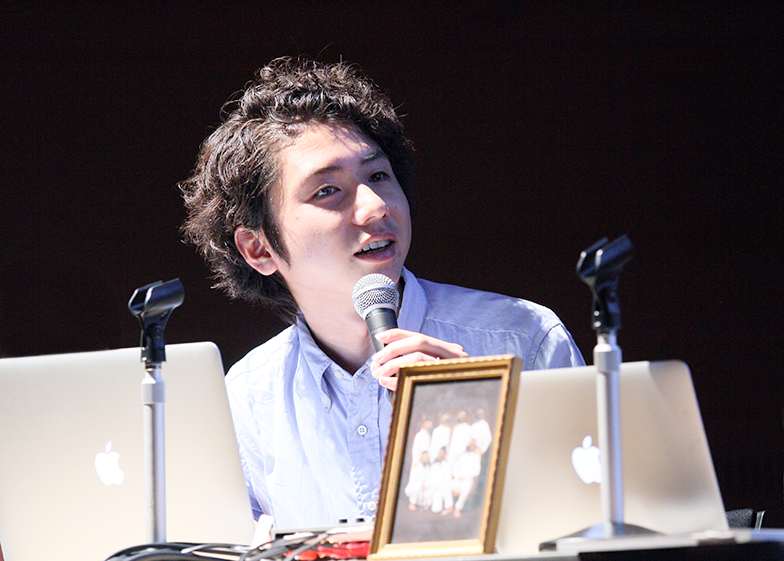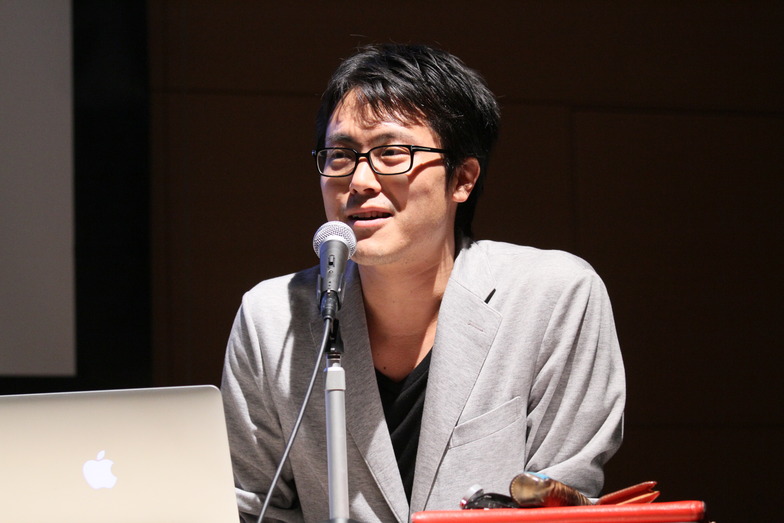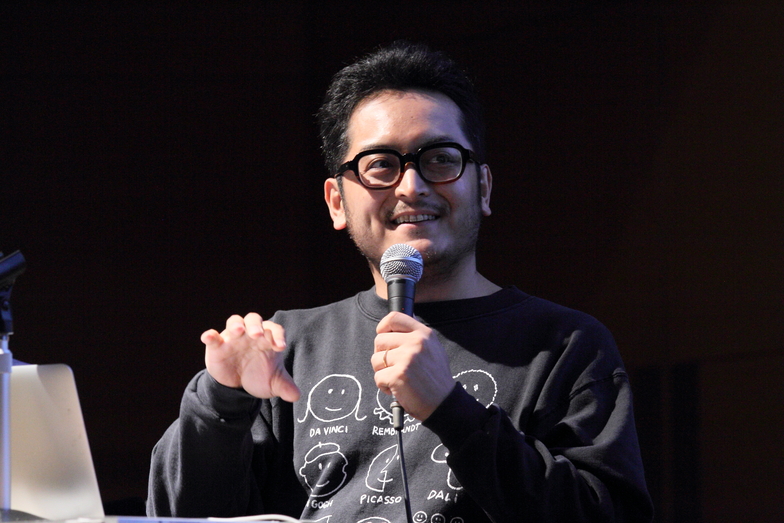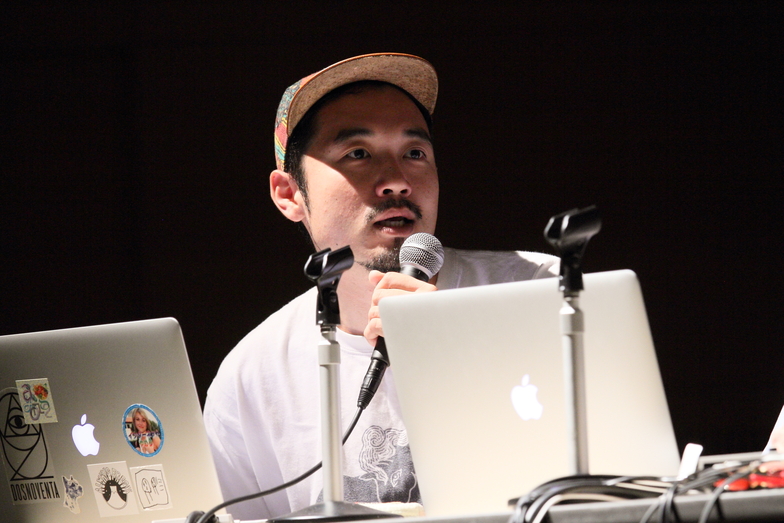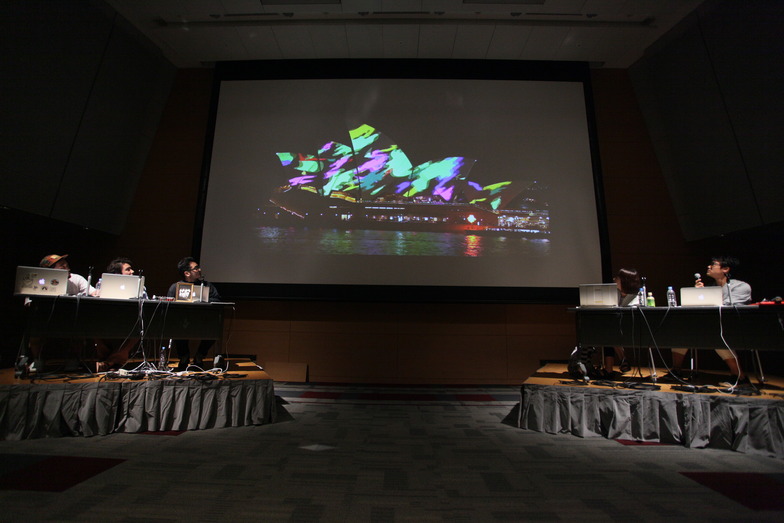TYMOTE continues to produce works brimming with creativity and originality across a wide range of fields—graphic design, video production, installations, spatial design, and sound design—by reconstructing the diverse personalities and specialties of its members. Gaining attention internationally, they now receive offers from both Japan and abroad. Rika Eguchi, an Art Director at Dentsu Inc. who has worked with them, and Takuya Fujita from the Event & Space Design Bureau, host a talk show featuring three members of TYMOTE—Satoshi Murai, Hitoshi Morita, and Takahiro Yamaguchi—delving into the ideas and methods behind their creative work.
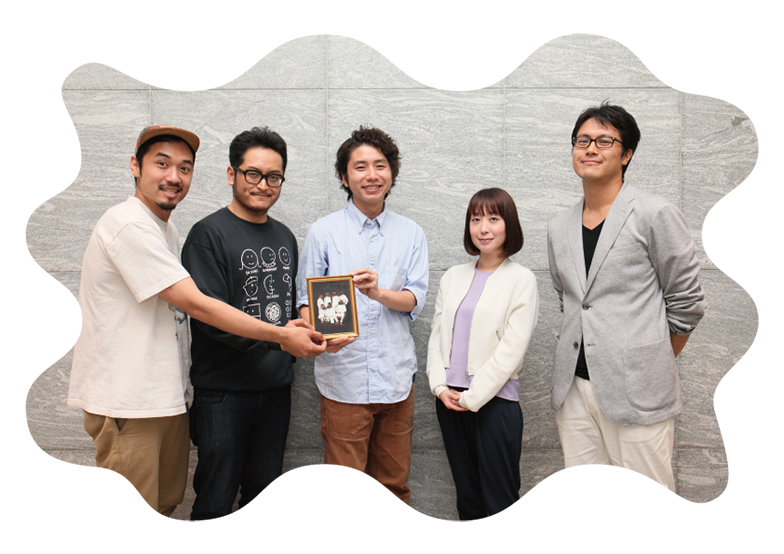
(From left) TYMOTE: Mr. Yamaguchi, Mr. Murai, Mr. Morita; Dentsu Inc.: Ms. Eguchi, Mr. Fujita
TYMOTE, a creative team founded by art school classmates
Creative Team
Eguchi: My first encounter with TYMOTE was working together on a commercial project late last year. It started when someone from the production company introduced us. Despite tight time and budget constraints, they delivered a remarkably polished video. They seem to effortlessly create wonderful work with such ease. I'm curious about their actual creative process. I'd love to hear more about it today.
Fujita: The tactile feel, warmth, and emotion are what I love about TYMOTE's style. Even though their work spans a wide range, you feel that common thread in everything they do. Today, I want to delve into the charm and mystery of TYMOTE.
Murai: TYMOTE is a creative team founded by members born in the 1980s during their student days. We currently have nine members. For the 2007 exhibition "The SIX" at Yokohama Red Brick Warehouse, members from Tama Art University, Musashino Art University, Kuwasawa Design School, and others came together to create work as "TYMOTE" for the first time. Fundamentally, we're a "company created by graphic design enthusiasts who graduated from art universities," but we do everything from video to spatial design, graphics, and sound design—and that versatility is our strength.
Fujita: TYMOTE has a strong image for video work, but what kinds of installation and graphic projects do you handle?
Morita: Last year, TYMOTE handled the entire " MESSAGE " project for ISSEY MIYAKE INC.'s 2014 holiday promotion. We managed everything from visuals and video to the website, in-store displays, and in-store interactions. Since the theme was gifts, we wanted to convey feelings and words of gratitude. Using the brand's limited-edition products, we created typography from A to Z.
Yamaguchi: On the special website, we assigned sound files to each individual letter, allowing users to create and send movie files with their favorite words. In-store, we also created a system where typing on a keyboard made letters appear and played music.
Murai: The graphic team creates the typography, and then our colleagues bring in all sorts of ideas. Working together, that's the style we've developed.
Eguchi: This is the work that also won Gold at the NY ADC, right? It's wonderful.
Fujita: My collaboration with TYMOTE was for an explanatory movie for "the WAVE," the Nissin Foods Group's technology, development, and research hub. I asked them to make the content—explanations about R&D and interviews with developers—as cute as possible. It's a long-form video around 15 minutes, but it turned out with TYMOTE's signature style, a movie even kids can watch all the way through.
Morita: For this project, the story flow was crafted by a scriptwriter, while we handled the animation and music. It was a challenge since we had no prior experience with character animation, but it gave us a tremendous amount of experience.
Eguchi: If you had to pick a favorite project, what would it be?
Murai: " MTV81," definitely. It perfectly captured each of our personal obsessions at the time.
Morita: We handled the opening and ending for a web movie introducing Japanese culture overseas, creating graphics that extracted elements from ukiyo-e.
Fujita: I felt this with the Issey Miyake project earlier too—TYMOTE has a distinct Japanese aesthetic.
Murai: I hadn't consciously thought about that. Speaking of Japanese aesthetics, in 2013, I also worked on creating a booklet called "SOUL of JAPAN" to explain Shinto to overseas visitors during the Ise Grand Shrine's Shikinen Sengu ritual. It started when I suddenly got a call from the Shinto Shrine Association. I was surprised to hear it was downloaded over 2 million times from the web.
Eguchi: Do you create the sound for the videos yourself? What led you from graphic design into sound?
Murai: I handle it all myself. Since there are people who can do both video and graphics, rather than trying to do everything, I decided to focus on something different. With music, it all came together nicely.
Eguchi: Even when the graphic tone changes, there's a consistent TYMOTE feel. Maybe that's because the same person creates the sound each time.
Morita: That's right. Also, when we get a project, we share a similar instinct for choosing the right direction—like, "This feels right."
Murai: While each of us has our own ideas and preferences, there's a sense that everyone is mindful of what this fictional entity called TYMOTE is creating. We're really good at reading the room, you could say (laughs).
Feedback from individual experiences
to level up the whole
Yamaguchi: Since I'm involved with TYMOTE while also working at other design firms, I often give relatively objective feedback to members. We're now entering our seventh year of activity, and recently, everyone has started seeing what they want to do themselves. While still active in TYMOTE, some members are launching their own apparel brands, others are starting different creative teams—they're broadening their scope of activities.
Murai: We don't have to force everything through TYMOTE, but we also want to keep pushing what makes TYMOTE unique. We want to pursue expressions born from teamwork and those soft, thoughtful expressions even more.
Morita: It feels like everyone is leveling up in their own fields and feeding that back into TYMOTE.
Fujita: It's great that everyone has sensitive antennas and we can share insights. What kind of work has been increasing lately?
Morita: We're getting more work from overseas too. Our latest project was projection mapping for the Sydney Opera House. With international clients, comments and messages come in via Vimeo, which often leads to new projects.
Yamaguchi: The most buzz on Vimeo was definitely the remix MV for Clammbon's " Rough&Laugh."
Eguchi: Interesting. So offers come from people around the world who see this kind of work.
Morita: Another recent job was creating an introductory video for JINS' MEME eyewear, aimed at developers.
Eguchi: You're really good at conveying things clearly and interestingly using just visuals.
Morita: I dislike relying too much on verbal explanations in videos. I strive to pare down information as much as possible and make things intuitively understandable.
Fujita: Are there any areas you'd like to tackle next?
Murai: For me, it's live-action filmmaking. For the interview video we released this year at Narita Airport Terminal 3, I challenged myself with directing, music, and editing. I'm always trying new things, and what's great about TYMOTE is that if I feel uncertain, I can immediately check with the team.
Morita: When making videos, we can also consult about sound right away. It's a great environment.
Murai: It's like a school in the best sense—we can teach each other when we don't know something.
Morita: I want to increase projects like the Issey Miyake one, where we can work as a team. I felt the joy of working together and the explosive power that comes from collective thinking. On top of that, it was a project that earned recognition and gave us a real sense of accomplishment.
Murai: We're lucky. There were times we couldn't make ends meet, but seniors and colleagues looked out for us. They gave us work saying, "You guys seem interesting, give it a shot," and that's how we built our track record. Since we started getting work while still students, at first we didn't know how to get jobs, what we could actually do, or how our work would be received in the world.
Morita: That's why we've always aimed for over-quality... over and over.
Eguchi: Clients are happy when you bring that kind of work to them, right? Thank you for today.
<End>
You can also read this interview on AdTie!
Planning & Production: Dentsu Inc. Event & Space Design Bureau, Aki Kanahara





